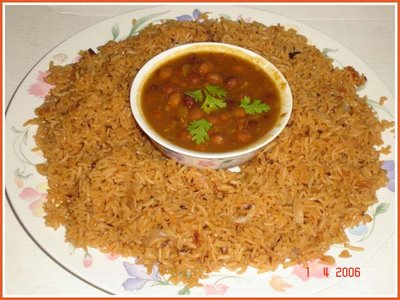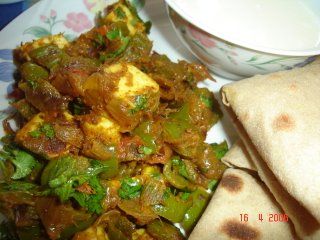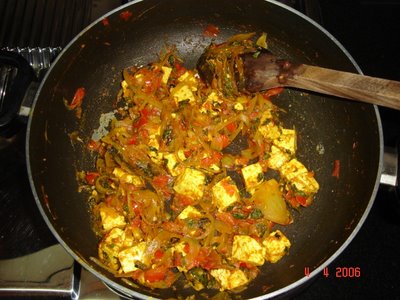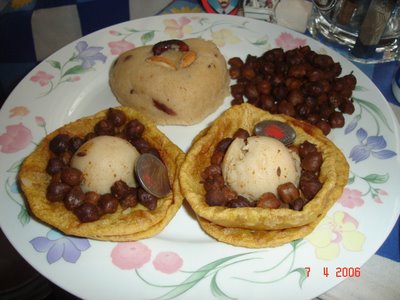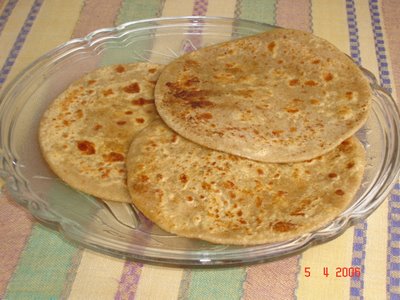Kaale Chane Rasse Waale
Translated to English, this would mean Bengal Gram Curry! Packed with Iron and Proteins, this is a very healthy and nutritious curry and teams up very well with Brown Jeera Rice (Recipe below).
1. For the gravy: 2 tomatoes, 1 big onion, 6-8 glakes of garlic, 1" piece ginger
2. 1 cup of Kaale Chane soaked overnight in water, 3 tbsp oil 3. Whole Spices: 2 Laung(Cloves), 2 Moti Illaichi(Black Cardamom), 2-3 Dalchini sticks(Cinamon)
4. Powdered Spices: 1/4tsp Turmeric, 1tsp Salt, 1/2 tsp Red Chilli Powder, 1 tsp Coriander Powder, 1/2 tsp Garam Masala, 1tsp Chana Masala, 1/2 tsp Amchoor(Dry Mango Powder), 1/4 tsp Black Pepper Powder
5. 1 tbsp Kasoori Methi
- The Black Chanas soaked overnight in water need to be drained and washed well and then pressure cooked with around 4 cups of water and 1 tsp of salt. They take quite a while to become soft..around 4 whistles on the pressure cooker and then keeping it on low flame for another 15-20 minutes should do it.
- The ingredients as listed in 1. need to be made into a paste in the mixer.
- Now, for the actual part...I heated the oil in the pressure cooker itself(the boiled Chanas with the liquid were emptied into another pan). I went on to add the whole spices listed out in 3. Waited for a minute and then added the paste to it and stir fried it for around 10 minutes till is became dry and golden brown-reddish in colour.
- Next its time to reduce the heat and add in all the powdered masalas in 4. after which the whole thing needs to be stirred for a couple of minutes more. I took out a 3-4 tbsps of the boiled chanas, mashed it and added it to the paste so that it becomes thick, rather than adding the chanas and then going about mashing some of them! Right, so we stir it for a minute more so that the mashed Chanas blend in with the paste. Adding around 1 tbsp Kasoori Methi leaves, rubbed between fingers and crushed finely, at this stage imparts a good flavour to the curry.
- Next I added the remaining Kaala Chanas reserving the water aside. After 3-4 minutes of stir frying it, I added the reserved water to it, closed the pressure cooker lid and let it cook till another whistle.(This was to enure that that the gravy gets absorbed into the chanas well!)
Garam garam Rassedaar Kaale Chane...taiyaar(ready)!!!
My homework on Kale Chane/Channa
This hard and dark brown gram with a thick husk is also know as Bengal Gram, Black Gram, Black chick-pea. What confuses me as to why is it called black chick pea because the gram is brown and not black! Moreover, we usually refer to the Sabut Urad Dal as Black Gram. So, if anyone could tell me about it, it'll be helpful.
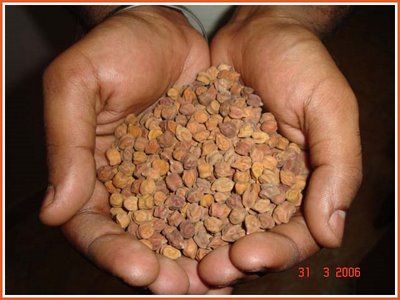
This is the gram from which chana dal and besan (chickpea flour) are made.
Shyamala of "Food In the Main", whose blog I follow, has a somewhat similar recipe for this dish - Kaala Chana Curry. Have to try out her method soon to see if it tastes different from this. Comparing notes from how she made it and the way I went about it, I had doubts like: She uses blanched tomatoes - does that make the dish taste different, used finely chopped onion and tomatoes and didn't make them into a paste like I did - does it matter, pressure cooked the whole spices with the Chanas itself than sauteing them in oil - will that make a difference? , Added just the Chana masala unlike me who added so many spices, she omitted garlic and added cumin and green chillies. See that's where I get lost...though her recipe is quite similar, but it has subtle differences. I hope my restless mind will be put to ease soon if I get answers for these queries!
Other dishes that can be made with Kale Chane are: tossed in with some salad, dry version like the one made as a prasad on Ashtami, Kebabs & Tikkis, Sanjeev Kapoor's Rajasthani version of it, made with Coconut Milk like Keralites do, the Bihari version - Ghoomni, The Bengali style - Ghughni (Though Ghughni can also be made with dried white peas, white chick peas, peas etc) and even Kaale Chane Parathas! Wow...that's a lot! There I go! I started off with one curry recipe for Kaale Chane and here we have so many other ways to have have this healthy chana! Have to try them all....soon!
Brown Jeera Rice
1. 1 cup rice, 2 cups water, 2 small onions sliced finely
2. 1tbsp sugar, 3 tbsp water
3. 3 tbsp Ghee, 1 tsp Salt or to taste
4. 1" stick Dalchini(Cinamon), 1 Tej Patta(Bay Leaves), 3-4 Laung(Cloves), 1 Choti Illaichi(Green Cardamom), 3-4 Sabut Kaali Mirch(Peppercorns), 1 tsp Jeera(Cumin seeds)
- Initial Step: The rice must not be soaked. I washed the rice well and then strained it keeping it in the strainer for 30 minutes.
- For The Brown colour: I mixed sugar and water in a heavy bottomed wide kadhai. It needs to be cooked on low flame till it is rich brown in colour. Next, I reduced the heat and add the 2 cups of water to it and stirred till it dissolved. I removed it from fire and kept the brown sugar water aside in a separate pan.
- The Actual Part: I heated the ghee in the same kadhai and added all the sabut whole spices (No. 4 on the ingredient list) ending with the Jeera. When it turned golden, I added in the sliced onions and stir fried it on medium heat till it was rich brown in colour (but not burnt!). Then it was time to add the rice and folded it in gently for 1-2 minutes. Then added the brown sugar water and salt. Brought the whole thing to boil, covered the kadhai with a well fitting lid (so that the steam didn'tescape) and cooked it on a very low flame till all the water got absorbed and the rice turned soft. Fluffed it up with a fork and served.
There you go...Kale Channe Rasse Walle with Brown Jeera Rice...my first blogged meal!!!
